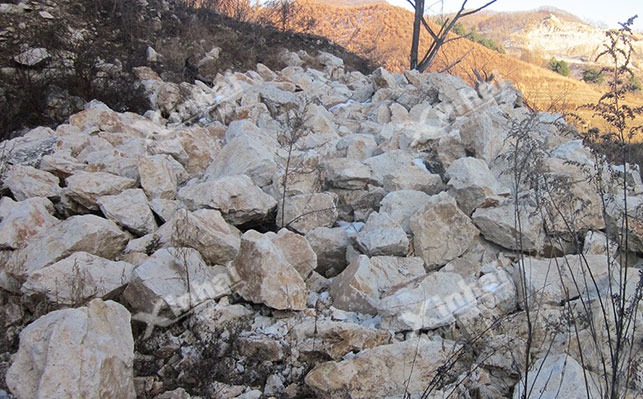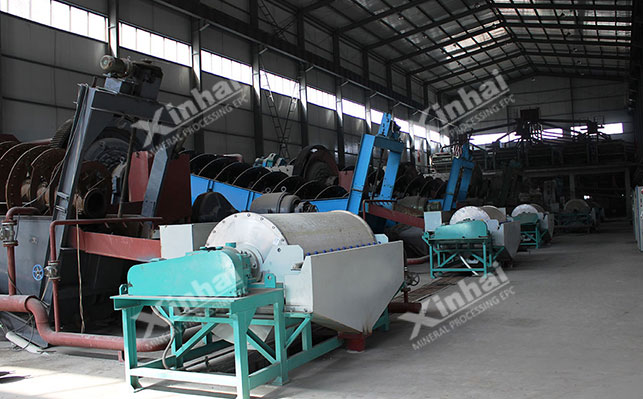Potassium feldspar ores in nature usually contain a variety of impurities, such as quartz, mica, rutile, magnetite, etc. If you want to apply potassium feldspar to industries such as ceramics and glass, you need to remove these impurities, and then you need to use potassium feldspar beneficiation technology. This article introduces six commonly used combined beneficiation processes for potassium feldspar beneficiation.

It is difficult to purify potassium feldspar with a single beneficiation process, because there are many impurities in the original ore, and their properties are different. Therefore, different process methods are needed for different impurities, and then combined beneficiation technology will be used. Common potassium feldspar beneficiation combined processes include the following six types:
Magnetic separation-flotation method is mainly aimed at potassium feldspar ores with high iron content. This process first uses magnetic separation to remove impurities such as iron minerals, biotite and tourmaline with certain magnetism, and then flotation is used to remove the remaining impurities, such as quartz, mica, etc. This process combines the advantages of magnetic separation and flotation, and can more thoroughly remove impurities and improve the purity of potassium feldspar.
When separating potassium feldspar from mica, the reverse flotation process is often used. Most concentrators use amine cationic collectors for reverse flotation under acidic conditions, which can reduce the loss of feldspar in mica flotation. After reverse flotation, strong magnetic separation can be carried out to further remove weakly magnetic minerals in potassium feldspar ore and remove impurities more thoroughly.
The acid leaching-flotation combined process is to first remove most of the iron minerals by acid leaching, and then separate a small amount of iron-stained compounds by flotation. For some iron impurities with fine embedded crystal structures, magnetic separation cannot achieve a good separation effect, so acid leaching is used at this time. The product after acid leaching is used as a flotation raw material, and sodium oleate is used as a collector for flotation to separate a small amount of iron-stained compounds, which can significantly improve the whiteness of potassium feldspar and achieve better iron removal effect.
The flotation-magnetic separation combined process first performs flotation to remove iron and titanium minerals in potassium feldspar and separate feldspar from quartz. Select appropriate flotation reagents according to different impurities, such as reverse flotation when separating potassium feldspar from mica, and acid flotation, neutral flotation or alkaline flotation when separating potassium feldspar from quartz. After flotation, magnetic separation is performed to remove impurity minerals with weak magnetism and further improve the purity of potassium feldspar. The operating sequence of this combined process can gradually remove different impurities and improve the mineral processing effect.

In the scrubbing-magnetic separation-flotation combined process, scrubbing plays an important role. Scrubbing can remove impurities and attachments on the surface of potassium feldspar and improve the purity and quality of potassium feldspar. Then magnetic separation is performed to remove magnetic impurity minerals such as iron minerals, biotite, tourmaline, etc. Finally, flotation is carried out to further remove the remaining impurities and improve the purity of potassium feldspar. The advantage of the whole process is that it can comprehensively utilize the advantages of scrubbing, magnetic separation and flotation to more thoroughly remove impurities and improve the product quality and mineral processing effect of potassium feldspar.
The desliming-strong magnetic-acid leaching combined process first removes the primary ore slime in the potassium feldspar ore and the secondary ore slime produced by grinding through desliming. These ore slimes will affect the subsequent flotation, magnetic separation and other separation operations. Then strong magnetic separation is carried out to remove impurity minerals with weak magnetism. Finally, acid leaching is carried out to remove iron impurities in potassium feldspar, which is especially suitable for difficult-to-select potassium feldspar ores. The process flow of this combined process can effectively treat the characteristics of difficult-to-select potassium feldspar ores and improve the mineral processing effect and product quality.
In short, potassium feldspar beneficiation is a complex and changeable process. Before formulating a beneficiation plan, representative ore samples should be taken for beneficiation tests. According to the test results, targeted measures should be taken for the impurities contained in the original ore, and a beneficiation plan should be formulated to better achieve the purpose of removing impurities and purifying potassium feldspar.